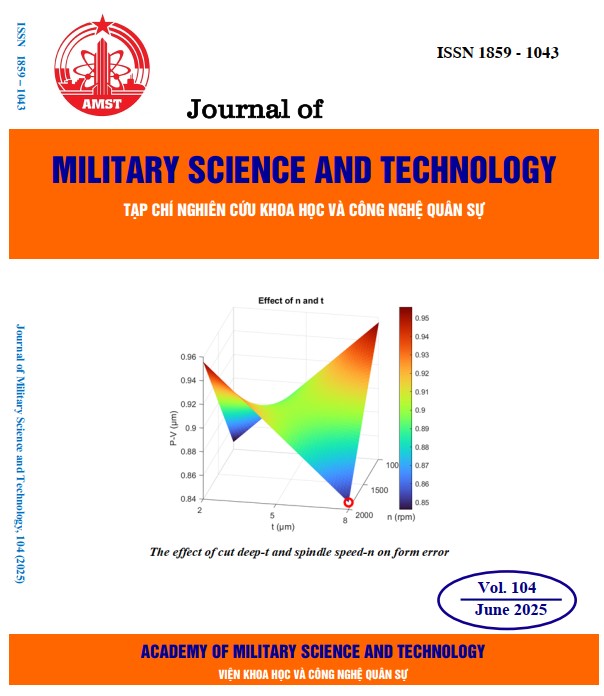Image fusion using FPGA in multi-sensor optoelectronic systems
258 viewsDOI:
https://doi.org/10.54939/1859-1043.j.mst.104.2025.130-136Keywords:
Multi-sensor optoelectronic system; FPGA; Image fusion.Abstract
This study proposes a foundation for developing a real-time image fusion system for multi-sensor optoelectronic systems applied in defense and security, aiming to enhance target detection by combining images from thermal imaging and low-light channels. The VIP Board Big V3.8 with Cyclone IV FPGA, a custom FPGA development board, which integrates key peripherals such as SDRAM, VGA, HDMI, and image sensors, is utilized. The main hardware modules have been designed, including global clock management (PLL), UART communication, FIFO buffers, LCD display control, and image fusion. The image fusion module employs an algorithm that decomposes images into two layers, the base layer and the detail layer, enabling efficient data fusion from two input images to generate a high-quality output image. Experimental results demonstrate that the system operates stably, meeting speed and low-latency requirements, paving the way for future research on more powerful FPGA platforms.
References
[1]. Sicong Zheng, “Pixel-level Image Fusion Algorithms for Multi-camera Imaging System”, Masters Theses, University of Tennessee, Knoxville, (2010).
[2]. Lei Yan, Qun Hao, Jie Cao , Rizvi Saad, Kun Li, Zhengang Yan & Zhimin Wu, “Infrared and visible fusion via octave Gaussian Pyramid framework”, Nature Research, (2021). DOI: https://doi.org/10.1038/s41598-020-80189-1
[3]. Ling Zhang, Xuefei Yang, Zhenlong Wan, Dingxin Cao, and Yingcheng Lin, “A Real-Time FPGA Implementation of Infrared and Visible Image Fusion Using Guided Filter and Saliency Detection” Sensors, 22, 8487, (2022). https://doi.org/10.3390/s22218487. DOI: https://doi.org/10.3390/s22218487
[4]. A. Boutros and V. Betz, "FPGA architecture: Principles and progression," IEEE Circuits and Systems Magazine, vol. 21, no. 2, pp. 4-29, (2021). DOI: 10.1109/MCAS.2021.3071607 DOI: https://doi.org/10.1109/MCAS.2021.3071607
[5]. T. Saegusa, T. Maruyama, and Y. Yamaguchi, "How fast is an FPGA in image processing?," in 2008 International Conference on Field Programmable Logic and Applications, (2008): IEEE, pp. 77-82. DOI: 10.1109/FPL.2008.4629911 DOI: https://doi.org/10.1109/FPL.2008.4629911
[6]. Li, S.; Kang, X.; Hu, J “Image fusion with guided filtering”, IEEE Trans. Image Process. 22, 2864–2875, (2013). DOI: 10.1109/TIP.2013.2244222 DOI: https://doi.org/10.1109/TIP.2013.2244222
[7]. Li, H.; Wu, X.J. “DenseFuse: A Fusion Approach to Infrared and Visible Images”, IEEE Trans. Image Process. 28, 2614–2623, (2019). DOI: 10.1109/TIP.2018.2887342 DOI: https://doi.org/10.1109/TIP.2018.2887342
[8]. Li, Q.; Han, G.; Liu, P.; Yang, H.; Wu, J.; Liu, D. “An Infrared and Visible Image Fusion Method Guid-ed by Saliency and Gradient Information”, IEEE Access, 9, 108942–108958, (2021). DOI: https://doi.org/10.1109/ACCESS.2021.3101639
[9]. A. F. Djomo, A. Tiedeu, and J. Fotsing, "Design and implementation in an Altera's cyclone IV EP4CE6E22C8 FPGA board of a fast and robust cipher using combined 1D maps," IET Image Pro-cessing, vol. 18, no. 7, pp. 1823-1843, (2024). doi.org/10.1049/ipr2.13066 DOI: https://doi.org/10.1049/ipr2.13066







